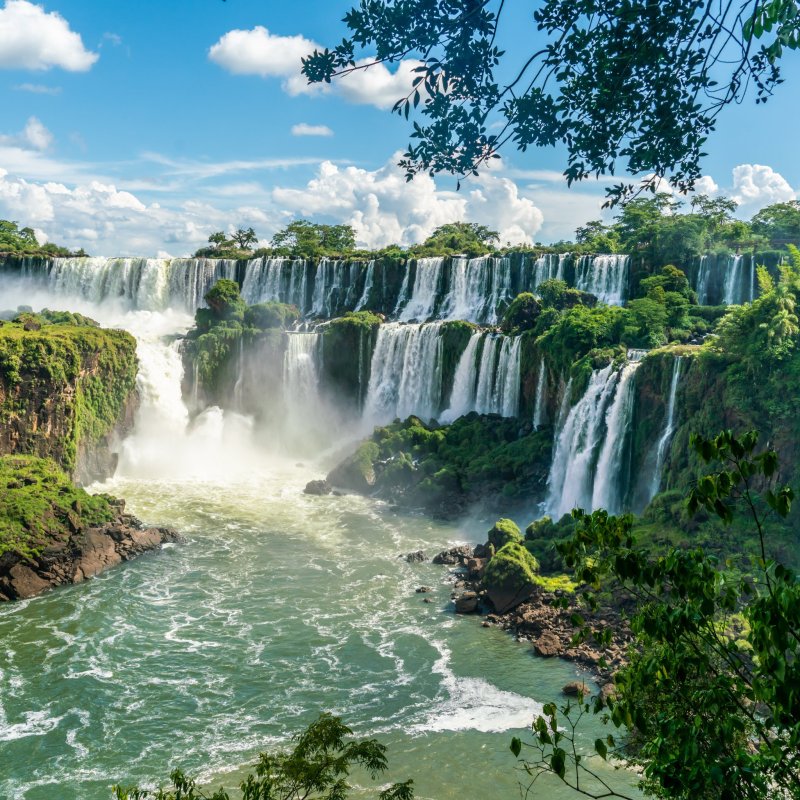
Who doesn’t love a waterfall? I’ve seen a few memorable ones like Niagara and the beautiful, much smaller, Multnomah Falls in Oregon’s Columbia River Gorge. Still, nothing prepared me for the sheer thrill of standing in the mist of Iguazu Falls.
Videos by TravelAwaits
Getting close to thundering water is hard to beat. The sound fills your head, the mist is intoxicating, and rainbows flicker in the mist. Waterfalls generate positive vibes too! The pounding water releases negative ions that increase serotonin, which eases stress and depression in the body. It also pumps up energy and boosts happiness. Remember, you’re mostly water; it’s no surprise that waterfalling resonates so pleasantly with the body’s primary element.
Make sure that you check out our picks for the best Iguazu Falls hotels.

Visit Three Countries At One Site
Iguazu River forms a spectacular border between three countries: Brazil, Argentina, and Paraguay. The widest span of the falls overflows from the Parana Plateau into a horseshoe shape between Argentinian and Brazilian parks. It’s been described as the Devil’s Throat, an “ocean plunging into an abyss.” While not as tall as Victoria Falls in Africa, it’s much wider.
Mark Another UNESCO Site Off The Bucket List
The falls impressed European explorers as early as 1541 when Spanish Alvar Nunez Cabeza de Vaca first laid eyes on the great waters. Nearly 350 years later, a Brazilian army officer, Edmundo de Barros, led the movement to establish a national park at the falls. It wasn’t until the 1930s before both Argentina and Brazil created national parks at Iguazu, and in the 1980s, UNESCO designated both sides as World Heritage sites.

Choose From Two UNESCO Heritage Sites
The Brazilian side, which I visited, is a smaller park with a single circuit a little shy of a mile long. It was wondrous to see the falls from different angles as I traipsed along the trail. There are elevators to help those who need it get from the rim to the water. That was most appreciated by the seniors in my multigenerational group as well as those like myself who are sensitive to heat. There’s no reason to rush through the park. We filled half a day easily.
The Argentinian park is larger with three main circuits and a secondary one for those serious about hiking (the Macuco Trail).
Ride Into The Mist
As with Niagara, the only way to get soaking-wet close to the big water is with admission to a boat tour. With the soaring heat, it was bliss to get into the mist. We donned life jackets and were shortly scuttling across the rapids. Then our intrepid captain rode us into the base of one of the falls — repeatedly. I haven’t laughed so hard in a long while as the waters rolled over my shoulders. Good thing that the guides make sure you have life preservers and ponchos. If you approach the falls from the Argentinian side, Gran Aventura offers a number of boat options.

Birdwatcher Heaven
With careful observation and good luck, you can spot many exotic bird species from the trails on your own. We spied big beaked toucans lounging in the trees along the Devil’s Throat circuit but were able to get extremely close inside the Foz do Iguazu Bird Park.
With over 120 species, it’s one of the largest bird parks in Latin America and houses butterflies and reptiles as well. The trail can take up to two hours, and there’s a snack bar with a gift shop at the end.
There’s another animal park, Guira Oga, in Puerto Iguazu. Both are sanctuaries for injured or rescued creatures removed from animal trafficking. While the goal is to help them heal and be reintroduced to their habitat, the birds in the parks can’t be released. As we wandered the trails admiring them, it seemed that everyone was happy to be there. If serious birders are on the trip, schedule a bird watching tour with an expert.
Butterflies Galore
As we meandered the Iguazu trails, especially the switchbacks rising from the river, butterflies bounced through the air, nearly colliding with us. They’re drawn to the exotic orchids and other flowers basking wild in all that warm moisture.

Admire But Don’t Feed The Friendly Coatis
Picture a medium-sized dog with a long snout and ringed tail, and you have a good idea what coatis look like. Unfortunately, they’ve learned that tourists are great for take-out, but human food isn’t the best diet for the wild creatures. We marveled at the scavengers wandering beneath our table at the Porto Canoas Restaurant after hiking around the Iguazu Park.
Watch Out For Monkey Cai
These small monkeys are rare, but groups occasionally hang out near restaurants hoping for snacks from tourists. Encouraging them is risky. They can scratch and snatch sunglasses and wallets before you know it!

Glimpse Wild Tapirs
Our bus driver on the Itaipu Binational Power Station Tour was in no mood to stop for the clutch of tapirs that crossed the double lane road in front of us, but stop he did. It was hard to remain in my seat as we drew close. They were magnificent. The odd-shaped creatures shaped like furry, walking almonds are usually spotted at night, if at all.
Visit The Hotel Das Cataratas
After strolling along jungle trails, it was a treat to step into the civilized, colonial grace of the Belmond Hotel das Cataratas. Built in the 1950s, the property has recently been renovated. I remember soft lighting and burnished stone, wide verandas, and a turquoise pool — the latter for guests only. I treasure the silver pendant embossed with a coati that I picked up in the lobby jewelry shop. The hotel has several package tours that include luxury accommodations along with park admission with or without guides.
Interested in staying at the Hotel das Cataratas? Check out our guide to the best hotels in Iguazu Falls for more info about this and many more stunning hotels in the Iguazu region.

Shopping And Dining In Foz Do Iguazu
Of course, every kiosk and shopping district in the area has Iguazu souvenirs, but I recommend supporting the parks by first selecting mementos in their gift shops. We stayed in a Foz do Iguazu, which has Catuai Palladium, the fifth largest mall in the region. With their abundant air conditioning, indoor malls are very popular in Brazil. We especially enjoyed the food court with Brazilian dishes as well as fast food. I recommend trying local brews and visiting La Cabana for the churrascaria feasts for a special night out. The restaurant has a free, local shuttle.
Admire Local Murals
Brazil was one of the first countries to embrace mural art. About 10 years ago, graffiti was rampant with a blight of tagging on top of tagging. The trend was dragging neighborhood spirits and values down. The country came up with a unique solution and held a competition for the best artists. Invitations went out to international painters, and soon, landlords in the largest towns were competing for the best muralists. Today in Brazil, tall walls are embellished splendidly but look for artwork in odd places. The murals aren’t always grand statements, but the artwork has been flourishing with the country’s encouragement.

Stop At The Marco Das Tres Fronteiras
Having come so far to see Iguazu, it was no hardship to pull over at nearly every viewpoint. The obelisk at the Three Borders Landmark commemorates the spot where Brazil, Argentina, and Uruguay meet. There’s a grand plaza where dancers perform at sunset, and there are take-out food and souvenir stands. It’s a bit touristy but playful.
Don’t Miss Touring The Dam
The Itaipu Dam is one of the largest in the world, which shouldn’t be a surprise given the size of the falls. I think the Egyptian pharaohs would be as stunned as I was by the size and scope of the plant. Nearly 400 Eiffel Towers could be built from the iron and steel of Itaipu. The Eurotunnel excavation between France and England was eight times smaller, and over 200 football stadiums could be built from the concrete used there. The scale is breathtaking — the main dam reaches over 65 stories high. Hop on one of the daily buses running on a rotating schedule around the plant. The impressive electrical output equals nearly 550,000 barrels of oil daily used at the largest oil-fueled plants. It’s an environmentally positive power source for the region and well worth a few hours on your Brazil itinerary.

Pro Tips
Iguazu Falls is set in a tropical jungle, so be prepared for humid and very hot days. The mildest weather is between April and May, as well as September to October. Those times are also less crowded, especially if you go on a weekday. During those periods, it’s a bit less hot; however, the best plan is to dress in light, breathable fabrics.
Any tropical area is prone to clouds of mosquitoes. I’m unfortunately prime bait for the biters and used an herbal bug repellant daily. With a little perseverance, shopkeepers are happy to help you find a spray. Rain ponchos were perfect during the boat tour, but we didn’t need them during the rest of the trip. You can bring or pick up an umbrella for rain or shelter from the scorching sun. Make sure to use a strong sunblock, carry a good shade hat, and bring comfortable walking shoes that dry quickly.
